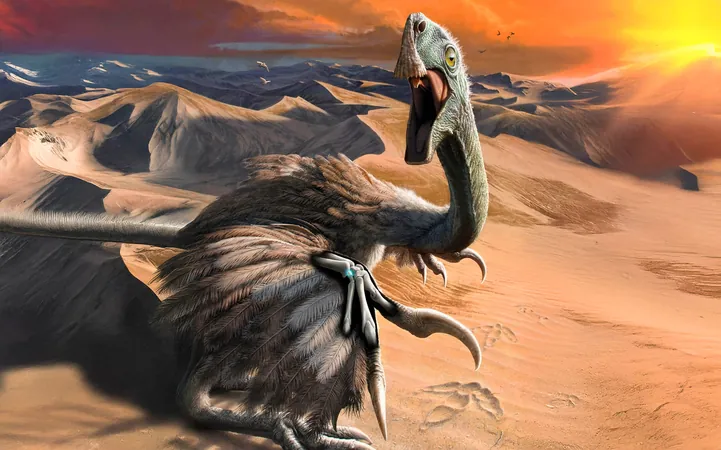
Unveiling Flight's Origins: Tiny Dinosaur Wrist Bone May Hold the Key!
2025-07-15
Author: Li
A Groundbreaking Discovery in Dinosaur Evolution
Recent scans of two small predatory dinosaurs have revealed a pea-sized wrist bone that was once thought to be exclusive to birds. This research suggests that the potential for flight was already brewing in dinosaur arms long before the first creatures took to the skies.
The Research Team's Exciting Findings
Led by James Napoli of Stony Brook University, in collaboration with the American Museum of Natural History and the Mongolian Academy of Sciences, this study challenges earlier beliefs that theropods lacked a bird-like pisiform bone. The research paves the way for a thrilling new perspective on how flight may have evolved.
Revolutionizing Our Understanding of Dinosaur Wrists
Modern birds utilize their wrist bones to fold their wings efficiently when they bend their elbows. It turns out that the pisiform bone, which migrated from one part of the wrist to another, plays a crucial role in this process. For years, scientists believed non-avian dinosaurs didn't make this evolutionary switch. However, Napoli's team conducted CT scans on a well-preserved troodontid and an oviraptorid, revealing a bead-like bone in the same position as the modern bird's pisiform.
Conjectures about the Evolution of Flight
Napoli notes, "This discovery pushes the timeline of wrist evolution back to the Pennaraptora, a group of feathered theropods that includes the infamous velociraptor. It begs the question: how many times did flight evolve among dinosaurs?" The research suggests that experimentation with flight may have only begun once the pisiform shifted position in the wrist joint.
A Gradual Evolutionary Transition
The scientists believe that the shift from the ulnare bone to an enlarged pisiform wasn't abrupt but rather a gradual process. This adaptation mirrors other avian characteristics, such as hollow bones and enlarged brains, which developed gradually throughout the evolutionary history of theropods.
Delving Deeper with Cutting-Edge Technology
The identification of the pisiform bone was a blend of luck and advanced technology. The fossils, found in Mongolia's Cretaceous rocks, remained intact, allowing researchers to conduct micro-CT scans with a resolution below 50 microns. This precision uncovered the intricate details needed for distinguishing the pisiform from other wrist bones.
Distinct Paths to Flight
The findings imply that flight could have evolved multiple times within Pennaraptora. If the pisiform's relocation coincided with elevating other features, it may have set the stage for aerial capabilities in separate lineages, similar to upgrades seen in pterosaurs and even bats.
Implications for Non-Flying Relatives
Although creatures like Velociraptor did not fly, they may have benefited from an efficient wrist mechanism through feathered arms for display or balance. This evolutionary adaptation hints that some prehistoric behaviors mirrored those of modern birds.
Next Steps for Researchers
Looking forward, the research team aims to scan more fossils to pinpoint when the pisiform made its dramatic entrance into the dinosaur wrist. Future studies will explore whether this change was linked to the development of longer feathers or shifts in muscular composition.
The Bigger Picture: Evolutionary Changes Start Small
Ultimately, this study sheds light on how minute anatomical changes can lead to monumental evolutionary breakthroughs. A wrist bone no bigger than a marble may have been the catalyst for future generations of creatures soaring through the skies millions of years before true birds emerged.
Published in the esteemed journal Nature, this research marks a significant milestone in our understanding of avian evolution. Stay tuned for more exciting discoveries!





 Brasil (PT)
Brasil (PT)
 Canada (EN)
Canada (EN)
 Chile (ES)
Chile (ES)
 Česko (CS)
Česko (CS)
 대한민국 (KO)
대한민국 (KO)
 España (ES)
España (ES)
 France (FR)
France (FR)
 Hong Kong (EN)
Hong Kong (EN)
 Italia (IT)
Italia (IT)
 日本 (JA)
日本 (JA)
 Magyarország (HU)
Magyarország (HU)
 Norge (NO)
Norge (NO)
 Polska (PL)
Polska (PL)
 Schweiz (DE)
Schweiz (DE)
 Singapore (EN)
Singapore (EN)
 Sverige (SV)
Sverige (SV)
 Suomi (FI)
Suomi (FI)
 Türkiye (TR)
Türkiye (TR)
 الإمارات العربية المتحدة (AR)
الإمارات العربية المتحدة (AR)